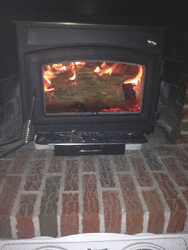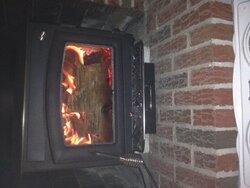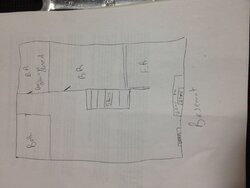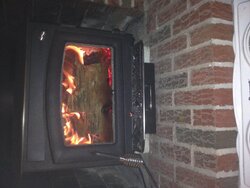after posting on here about my situation with my slam in wood stove configured into a fireplace and hearing what everyone has to say about safety, needing a full liner, etc i have decided to take my wood stove back due to the cost of the ss liner that i would need. soooooo my question to everyone is how can i get the most efficiency from my fireplace. i know i know fireplaces are not the best efficient way to heat compared to a wood stove. Any ideas? i dont want to spend a ton of money on one of those fireplace blower grates. any help would be appreciated.
getting rid of the stove.....
- Thread starter Bowow
- Start date
-
Active since 1995, Hearth.com is THE place on the internet for free information and advice about wood stoves, pellet stoves and other energy saving equipment.
We strive to provide opinions, articles, discussions and history related to Hearth Products and in a more general sense, energy issues.
We promote the EFFICIENT, RESPONSIBLE, CLEAN and SAFE use of all fuels, whether renewable or fossil.
You are using an out of date browser. It may not display this or other websites correctly.
You should upgrade or use an alternative browser.
You should upgrade or use an alternative browser.
- Status
- Not open for further replies.
KaptJaq
Minister of Fire
You can start by reading this thread...
First home, fireplace advice needed
and this brief article...
http://www.motherearthnews.com/diy/improve-your-fireplace-efficiency.aspx#axzz2mHCWg26G
Basically open fireplaces are not efficient, they are ambiance.
KaptJaq
First home, fireplace advice needed
and this brief article...
http://www.motherearthnews.com/diy/improve-your-fireplace-efficiency.aspx#axzz2mHCWg26G
Basically open fireplaces are not efficient, they are ambiance.
KaptJaq
My Oslo heats my home
Minister of Fire
fireplaces are for aesthetic reasons only in todays world. It's too bad you couldn't find a way to make it work out.
Baker_Falcon
New Member
Wait a sec. You are going to get rid of the wood stove just because it is a slammer install? I read your last post and realize while the set up isn't ideal, you were cleared to burn by a licensed professional chimney sweep? Was he licensed? What did he have to say? There are plenty of folks that run slammer installs and did not burn the house down especially considering the chimney is clean to begin with. Just because you have a slammer install doesn't mean you are going to magically have a chimney fire. While we realize it isn't the best set up, it can be done safely with proper precautions. Use SEASONED good hardwood, burn a good hot fire and make sure you check the creosote buildup often.
Baker_Falcon
New Member
KaptJaq
Minister of Fire
Wait a sec. You are going to get rid of the wood stove just because it is a slammer install? I
It is not a "slammer install" It is a "Direct connect" install. Slammer installs have no pipe, the insulation around the face of the fireplace forces air through the stove. Slammer installs are not to code in most areas.
The direct connect is to code. The two problems with them are:
1. Not enough draft due to an oversized flue. Since you are in the basement I'm going to guess you have a longer than necessary flue. If it is long enough and internal you should have a good draft. Just make sure you have a well sealed block-off plate.
2. Cleaning the flue. Since you do not have a full liner it takes a while for the flue to warm up. During this warm up time some creosote builds up on the flue. Make sure you burn dry wood and check the flue regularly for buildup. When you have to clean it you have to pull the stove, block off plate, and pipe to do it properly.
People around here don't like slammer and direct installs. If used properly they can be safe, you just need to know what to look for and how to maintain them. My parents had a true slammer install for over 20 years. Never a problem. They burned dry wood and checked the flue regularly.
Get rid of the stove because it cannot do the job for you, not because some people feel it cannot be used safely.
KaptJaq
Last edited:
O
You seem to know a lot about this, is there insulation u can put around the block off plate to keep heat in
It is not a "slammer install" It is a "Direct connect" install. Slammer installs have no pipe. The insulation around the face of the fireplace forces air through the stove. Slammer installs are not to code in most areas.
The direct connect is to code. The two problems with them are:
1. Not enough draft due to an oversized flue. Since you are in the basement I'm going to guess you have a longer than necessary flue. If it is long enough and internal you should have a good draft. Just make sure you have a well sealed block-off plate.
2. Cleaning the flue. Since you do not have a full liner it takes a while for the flue to warm up. During this warm up time some creosote builds up on the flue. Make sure you burn dry wood and check the flue regularly for buildup. When you have to clean it you have to pull the stove, block off plate, and pipe to do it properly.
People around here don't like slammer and direct installs. If used properly they can be safe, you just need to know what to look for and how to maintain them. My parents had a true slammer install for over 20 years. Never a problem. They burned dry wood and checked the flue regularly.
Get ri
KaptJaq
You seem to know a lot about this, is there insulation u can put around the block off plate to keep heat in
KaptJaq
Minister of Fire
O
You seem to know a lot about this, is there insulation u can put around the block off plate to keep heat in
Roxul or mineral wool can be put above the block-off plate to help seal the opening. Just make sure the pipe extends well above the mineral wool and the outlet is not obstructed in any way.
KaptJaq
Last edited:
Baker_Falcon
New Member
I just re read your original post again and I am having difficulty understanding how you are unable to warm the room beyond 70 degrees. Hell an open burning fireplace should get the room hotter than that. How hot of a fire are you burning? What wood are you using? Is there a blower on the stove? How are you making your fires?
I'm using oak and locust. It is seasoned for almost 1.5. I agree I should be roasting out of the basement. I start fire with newspaper and kindling then add some pieces then once I get some coals going then ill load it up. I know I start to sweat once I open the door and take coals around and put more wood on. Just isn't getting the basement up past 70 which don't get me wrong 70 is decent but I want more. I burnt the fireplace before I put the stove in and I had built a grate similar to the grate wall of fire and I had basement up to 77 From the fireplace. This is why I'm disappointed with the stove
From the fireplace. This is why I'm disappointed with the stove
 From the fireplace. This is why I'm disappointed with the stove
From the fireplace. This is why I'm disappointed with the stovebranchburner
Minister of Fire
how can i get the most efficiency from my fireplace.
By not using it.
At least not as a winter heat source. The combustion air has to come from somewhere, and in large amounts. In my house in the dead of winter, the longer we had a fire in the fireplace the warmer we got sitting by the fire, but the colder and draftier the rest of the house got... our huge flue was pulling in too much cold outside air, especially at the tail end of a burn where no effective heat was being thrown.
As BG pointed out, your small-firebox EPA stove is designed for optimum performance (good secondary combustion) only with optimum draft. If I was in a situation of financial need with ample seasoned wood on hand, my choice would be to get an inexpensive used stove with the largest possible firebox, and attempt a direct-connect as you had, paying special attention to all possible safety concerns. When funds allowed, I would then line the chimney.
Baker_Falcon
New Member
As BG pointed out, your small-firebox EPA stove is designed for optimum performance (good secondary combustion) only with optimum draft.
I see now that makes sense. Did not think about it being a small-firebox EPA stove.
KaptJaq
Minister of Fire
Can you post some pictures of your install? How big is the room the stove is in? Are the walls insulated?
When you got that room to 77° with the open fireplace what was the outside temperature? What was the effect on the rest of the house? When you run an open fireplace there is a lot of air sucked from the house and up the flue. Usually the rooms further away from the fireplace show a drastic drop in temperature. If it was not too cold outside this is not as noticeable but there is usually a net drop in heat in the house.
The advantage of an EPA stove is that you can control this airflow. Once the stove gets up to temps shut down the combustion air. The stove should launch it's secondaries and start a net gain of heat for the entire house. Have you burned an EPA stove before? Try playing with the air control according to the manual to see if you can get more heat out of it.
Heating from the basement is hard but if you get the basement warm then the heat slowly migrates up to the rest of the house. The 68K BTUs that stove is rated should make a noticeable difference. The stove might not be big enough to heat the whole house, but I am sure you will reduce the load on your primary heat source.
If you do run it at it's max output, 68k BTUs, do not expect to get 8 hour burns. With a 1.5 cf firebox I would expect about 4 hours at that rate with good dry hardwoods.
KaptJaq
When you got that room to 77° with the open fireplace what was the outside temperature? What was the effect on the rest of the house? When you run an open fireplace there is a lot of air sucked from the house and up the flue. Usually the rooms further away from the fireplace show a drastic drop in temperature. If it was not too cold outside this is not as noticeable but there is usually a net drop in heat in the house.
The advantage of an EPA stove is that you can control this airflow. Once the stove gets up to temps shut down the combustion air. The stove should launch it's secondaries and start a net gain of heat for the entire house. Have you burned an EPA stove before? Try playing with the air control according to the manual to see if you can get more heat out of it.
Heating from the basement is hard but if you get the basement warm then the heat slowly migrates up to the rest of the house. The 68K BTUs that stove is rated should make a noticeable difference. The stove might not be big enough to heat the whole house, but I am sure you will reduce the load on your primary heat source.
If you do run it at it's max output, 68k BTUs, do not expect to get 8 hour burns. With a 1.5 cf firebox I would expect about 4 hours at that rate with good dry hardwoods.
KaptJaq
Last edited:
Can you post some pictures of your install? How big is the room the stove is in? Are the walls insulated?
When you got that room to 77° with the open fireplace what was the outside temperature? What was the effect on the rest of the house? When you run an open fireplace there is a lot of air sucked from the house and up the flue. Usually the rooms further away from the fireplace show a drastic drop in temperature. If it was not too cold outside this is not as noticeable but there is usually a net drop in heat in the house.
The advantage of an EPA stove is that you can control this airflow. Once the stove gets up to temps shut down the combustion air. The stove should launch it's secondaries and start a net gain of heat for the entire house. Have you burned an EPA stove before? Try playing with the air control according to the manual to see if you can get more heat out of it.
Heating from the basement is hard but if you get the basement warm then the heat slowly migrates up to the rest of the house. The 68K BTUs that stove is rated should make a noticeable difference. The stove might not be big enough to heat the whole house, but I am sure you with reduce the load on your primary heat source.
If you do run it at it's max output, 68k BTUs, do not expect to get 8 hour burns. I would expect about 4 hours at that rate with good dry hardwoods.
KaptJaq
Outside temp was mid 20s when I got it up to 77. I had the basement door closed that is at top of stairs cuz my 1 year old was running around. The basement was nice an toasty everywhere except the back room where we keep door closed. This is my first wood stove. When u say air combustion I'm assuming that's the lever on the top right. It goes left to right. I would like to be able to get the stove cooking the basement up so maybe some of that eat will go upstairs when the door is open to try an take the chill off. 3.39 a gal for propane not really my fav thing to pay for
Attachments
KaptJaq
Minister of Fire
Follow the operating instructions on page 15 of your manual. Like I mentioned earlier it may take a few fires before you get a good, clean burn out of it. If you don't have the manual it can be found here:
http://www.hayneedle.com/images/PDF/UNIT011.pdf
If you cannot get the secondaries to launch or get it to burn smoke free you may have one or both of two problems. First, your wood may not be dry enough. Check it with a moisture meter ($20-$30 at Harbor freight or home depot). Or a draft problem due to the direct connect. A full liner should correct this.

KaptJaq
http://www.hayneedle.com/images/PDF/UNIT011.pdf
If you cannot get the secondaries to launch or get it to burn smoke free you may have one or both of two problems. First, your wood may not be dry enough. Check it with a moisture meter ($20-$30 at Harbor freight or home depot). Or a draft problem due to the direct connect. A full liner should correct this.

KaptJaq
My Oslo heats my home
Minister of Fire
I saw your 1.5 and thought the same thing. The oak in particular may not be dry enough.1.5 year old oak may not burn very well either... Just depends on if its wet still.
The next thing I would try that is inexpensive is to pack insulation around the damper area, well below the top of the short liner, then put a sheetmetal block-off plate under the insulation. Seal the edges with silicone. See if that doesn't improve draft a little and provide more heat into the room. And turn on the blower as soon as the stove gets hot.
- Status
- Not open for further replies.
Similar threads
- Replies
- 20
- Views
- 2K
- Replies
- 2
- Views
- 430
- Replies
- 4
- Views
- 480
- Replies
- 4
- Views
- 384




